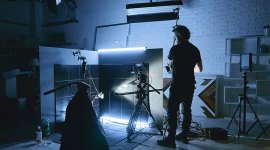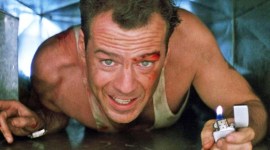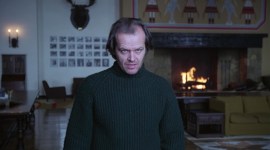
Every Article You Need to Make Your Own Multiverse Film
Hop through the portal to discover our practical guide for building your cinematic multiverse—no theoretical physics degree necessary.
If you asked someone a few years ago what would be one of the dominant themes of cinema and pop culture for 2022, I don’t think multiverse theory would come up as a top answer.
Yet, here we are. Or, at least, here we in this universe are.
From television shows like Rick and Morty to some of the biggest films of this summer with Marvel’s Doctor Strange in the Multiverse of Madness and A24’s Everything Everywhere All At Once (quite fitting to see Marvel and A24 duking it out in this space, isn’t it?), there’s a lot of multiverse content flying around right now.
But just because audiences seem to love having their brains stretched by these high-concept projects doesn’t mean that writing, shooting, and editing content in this space is easy to knock out. It’s quite difficult as multiverse projects require a lot of extra thought, execution, and care.
So, for all those taking inspiration from Doctor Strange or Daniels and trying to develop multiverse projects of their own, let’s break down some practical tips and tricks for building your cinematic multiverse.
A Strong Understanding of Sci-Fi (and String Theory)
Before we dive into tips for screenwriting and directing, let’s back up about as far as we can go. To create multiverse films and videos that feel genuine and smart, you will need to challenge yourself to understand the very roots of science fiction. (As well as, you know, perhaps study up on the physics and theoretical framework of string theory.)
No matter how many bells and whistles are attached, any multiverse project will be science fiction, which means you and your audience will need to interpret the project within the guidelines of the sci-fi genre itself. So, if you’re serious about the multiverse, it would be pretty helpful to be serious about sci-fi by studying the films that have been popular in the genre over the years.
You’ll also want to start doing your homework now on how sci-fi movies work, including how they’re written, shot, and edited—basically how they’re created from the ground up. Here are some great articles to start with:
- Sci-Fi 101: Tips for Creating Awesome Time Travel Films
- 5 Ways to Nail the Sci-Fi Look
- How to Speak Science Fiction: A Field Guide
- How to Create a Retro Sci-Fi Disintegration Effect in After Effects
- Futuristic Sci-Fi Synth: Royalty-Free Music for Ultramodern Noir Thrillers
Great Screenwriting (and Plot mapping) Skills
Once you’ve read up on your sci-fi theories and studied the sci-fi classics, you can begin the arduous task of conceptualizing and plot mapping your project. As a general rule of thumb, the script process for a short or feature narrative film should take anywhere from a few months to a few years. However, when working with something as complex as multiverses, this process could take you what feels like ages.
This is because plotting and screenwriting a multiverse script means you’re going to have to create a whole universe unto itself from the ground up—then combine that one with all the other ones you’re going to need to create.
Both Doctor Strange and Everything Everywhere have plenty of excellent examples of how much thought and care goes into these projects whenever we see their characters jump between multiple universes in a row. These are meant to be quick sequences overwhelming the audience with lots of different universe examples, and while we only see them for a few seconds on screen, they’ve undoubtedly been carefully conceived and constructed.
The Ability to Easily Create Different Environments
In these films mentioned above, the filmmakers almost employ the multiverse hopping aspects as a quick throwaway joke. It’s funny to see characters fly through different iterations of themselves or be turned into liquid goo for a few frames, after all. However, these throwaway gags can sometimes take more time to create than entire sequences or scenes.
For many, though, these quick sequences might be our favorite parts of the films as they really showcase just how imaginative films like these can be. The real trick for filmmakers simply becomes how to find the right balance of focus and resources to make each of these quick shots look fully realized and great, as well as the practical limits of shooting so many backdrops.
And this is where any aspiring multiverse filmmakers need to really hone their skills. If you can quickly create many different worlds, you’ll be able to create some genuinely fascinating sequences and gags. And in truth, many of these worlds are only available because of green screen technology and the myriad of ways filmmakers can cleverly create them out of scratch.
Check out these resources below to give you the best primer on green screen technology possible.
- Everything You Need to Know About Chroma Key and Green Screen Footage
- DIY: How to DIY a Green Screen on a Budget
- 7 of the Most Inventive Uses of Green Screen in Movies
The Editing Skills to Tie Everything Together
Finally, the real trick in creating and working with multiverses in your film projects is to work with talented editors (or be one yourself) who can tie everything together. As mentioned above, these types of projects undoubtedly have lots of green screen footage which needs to be combined with VFX.
Multiverse projects also need to have a deft hand at the helm who can stay focused on the story and narrative filmmaking principles while still having enough capacity to allow for the more gimmicky aspects of the concept to land.
There’s no real secret formula to how one edits a multiverse film. However, if you can find the kernel of truth at the story’s heart, you can work backward from there as you build out your characters and their universe first—before embracing the fun of adding in all the other wild and imaginative ones that you can dream up.
Feature image via A24.
Looking for more? Check out these articles on the Marvel cinematic universe.





